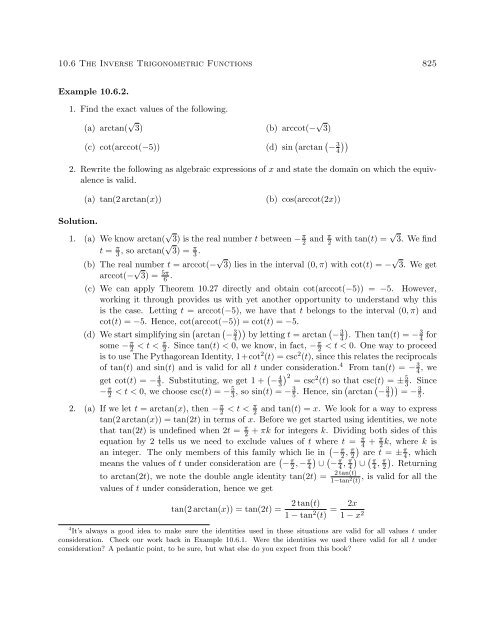Section 10.6: The Inverse Trigonometric Functions - Ostts.org
Section 10.6: The Inverse Trigonometric Functions - Ostts.org
Section 10.6: The Inverse Trigonometric Functions - Ostts.org
Create successful ePaper yourself
Turn your PDF publications into a flip-book with our unique Google optimized e-Paper software.
<strong>10.6</strong> <strong>The</strong> <strong>Inverse</strong> <strong>Trigonometric</strong> <strong>Functions</strong> 825Example <strong>10.6</strong>.2.1. Find the exact values of the following.(a) arctan( √ 3) (b) arccot(− √ 3)(c) cot(arccot(−5)) (d) sin ( arctan ( − 3 42. Rewrite the following as algebraic expressions of x and state the domain on which the equivalenceis valid.))(a) tan(2 arctan(x))(b) cos(arccot(2x))Solution.1. (a) We know arctan( √ 3) is the real number t between − π 2 and π 2 with tan(t) = √ 3. We findt = π 3 , so arctan(√ 3) = π 3 .(b) <strong>The</strong> real number t = arccot(− √ 3) lies in the interval (0, π) with cot(t) = − √ 3. We getarccot(− √ 3) = 5π 6 .(c) We can apply <strong>The</strong>orem 10.27 directly and obtain cot(arccot(−5)) = −5. However,working it through provides us with yet another opportunity to understand why thisis the case. Letting t = arccot(−5), we have that t belongs to the interval (0, π) andcot(t) = −5. Hence, cot(arccot(−5)) = cot(t) = −5.(d) We start simplifying sin ( arctan ( − 4)) 3 ( )by letting t = arctan −34 . <strong>The</strong>n tan(t) = −34 forsome − π 2 < t < π 2 . Since tan(t) < 0, we know, in fact, − π 2< t < 0. One way to proceedis to use <strong>The</strong> Pythagorean Identity, 1+cot 2 (t) = csc 2 (t), since this relates the reciprocalsof tan(t) and sin(t) and is valid for all t under consideration. 4 From tan(t) = − 3 4 , weget cot(t) = − 4 3 . Substituting, we get 1 + ( − 4 3) 2 = csc 2 (t) so that csc(t) = ± 5 3 . Since− π 2 < t < 0, we choose csc(t) = − 5 3 , so sin(t) = − 3 5 . Hence, sin ( arctan ( − 3 4))= −35 .2. (a) If we let t = arctan(x), then − π 2 < t < π 2and tan(t) = x. We look for a way to expresstan(2 arctan(x)) = tan(2t) in terms of x. Before we get started using identities, we notethat tan(2t) is undefined when 2t = π 2+ πk for integers k. Dividing both sides of thisequation by 2 tells us we need to exclude values of t where t = π 4 + π 2k, where k isan integer. <strong>The</strong> only members of this family which lie in ( − π 2 , π )2 are t = ±π4 , whichmeans the values of t under consideration are ( − π 2 , − π ) (4 ∪ −π4 , π ) (4 ∪ π4 , π )2 . Returningto arctan(2t), we note the double angle identity tan(2t) =2 tan(t) , is valid for all the1−tan 2 (t)values of t under consideration, hence we gettan(2 arctan(x)) = tan(2t) =2 tan(t)1 − tan 2 (t) = 2x1 − x 24 It’s always a good idea to make sure the identities used in these situations are valid for all values t underconsideration. Check our work back in Example <strong>10.6</strong>.1. Were the identities we used there valid for all t underconsideration? A pedantic point, to be sure, but what else do you expect from this book?


